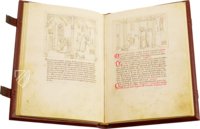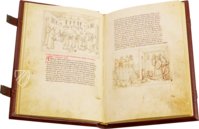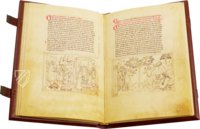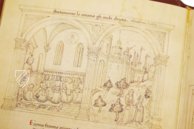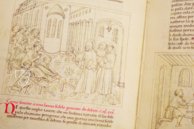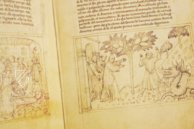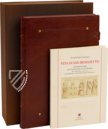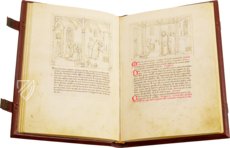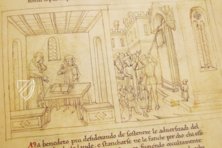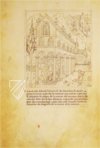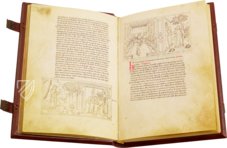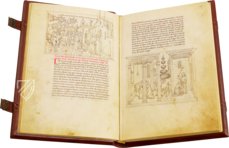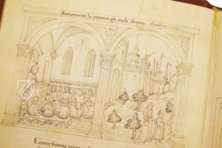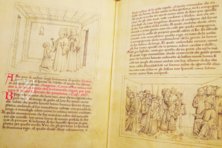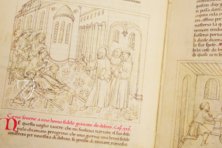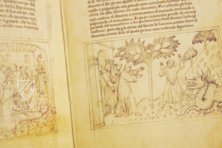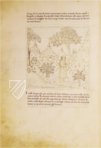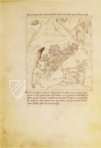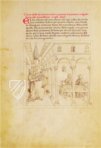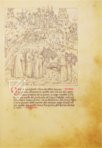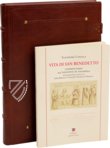Life of Saint Benedict
(1,000€ - 3,000€)
Born shortly after the collapse of the Western Roman Empire in Nursia (modern day Norcia), Italy, Saint Benedict is renowned for authoring the Rule of Saint Benedict in 516 and for founding Montecassino Abbey in 529. As such, he is regarded as the Father of Western Monasticism and one of the most important figures of the early church who had a long-lasting impact. His life story is told in this manuscript illustrated by 87 pen and ink drawings of the highest quality, which was created in Italy during the 1460’s. Aside from the life of the saint, the manuscript is an impressive testimony to monastic life during the 15th century. The miniatures offer glimpses of not only church interiors but also communal rooms, loggias, living quarters, chapter houses, gardens, refectories, and kitchens. Aside from monks in flowing robes, laypeople from various classes are depicted dressed in the fashions of contemporary Italy and many cityscapes also serve as artful backgrounds.
Life of Saint Benedict
Created over 900 years after his death, this gorgeously designed manuscript artfully illustrates the life of Saint Benedict (480–540), the revered Father of Western Monasticism, and attests to the lasting impact he had on the Church. Information on the life of Saint Benedict primarily comes from two sources, one comes from Book 2 of St. Gregory the Great’s Dialogues, which is supposedly based on the accounts of four of Benedict’s disciples, and the other a poem created by a monk at Montecassino after his death. This manuscript and its 87 masterful pen and ink drawings depict both historically reliable events and popular legends from the life of the saint and sets them in the splendor of the Italian Renaissance.
The World of Saint Benedict
Benedict was born into a noble Roman family in modern Norcia, Italy on March 2nd, 480. The general Odoacer had deposed the last Roman Emperor – a 12-year-old named Romulus Augustulus – four years earlier with the support of the Senate. He was the nominal client of the Eastern Roman Emperor Zeno but effectively ruled as the autonomous King of Italy until he betrayed his master, causing Constantinople to call upon its ally, the Ostrogothic King Theodoric, who defeated and supplanted Odoacer in 493. Rather than introducing a Dark Age, Theodoric the Great not only maintained the legal administration and scholarly culture of Rome but patronized major building projects, restored hegemony over most of the former Western Roman Empire, and promoted Christianity. As such, Benedict lived in a period of cultural revival in the West and did not flee the Eternal City and abandon his studies ca. 500 because of instability but rather left in disgust with the licentiousness of Rome.
The Road to Sainthood
After initially moving to the nearby town of Enfide, modern Affile in Metropolitan Rome, with his old nurse and servant, he found an isolated cave above a lake, took vows as a monk at a local monastery where he received a monk’s habit, and spent the next three years as a hermit near Subiaco. After unsuccessful attempts at living with other monks that resulted in two attempted poisonings, both of which Benedict avoided by performing miracles, he went on to found twelve monastic communities in the vicinity of Subiaco from his own followers. It was during this period that he wrote the Rule of Saint Benedict.
In 530, he selected a strategic hilltop between Rome and Naples as the site for Montecassino Abbey, which would go on to be one of the most important and influential religious and cultural centers of medieval Europe. Benedict performed one of his final miracles during the invasion of Totila in the 540’s when the Gothic king had one of his generals wear his royal robes, but Benedict immediately detected the ruse and Totila was thoroughly impressed. In the end, he not only attained sainthood, but was eventually named one of the patron saints of Europe and his Rule is still the most common and influential among monastic communities.
Late Antiquity Set in the Renaissance
This manuscript originated during the 1460’s and as was customary, the events are illustrated in contemporary garments, architectures, tools, and everyday objects. Although the 87 pen and ink drawings are uncolored, they are first rate nonetheless and exhibit the technical skills of the anonymous Italian artist or artists involved in creating them. Not only do they realistically depict space and perspective, but they also often represent multiple events within the same image, sometimes sequentially and sometimes concurrently.
The interior spaces of some churches exhibit vaulted sealings supported by columns and windows with quatrefoil traceries and mullions while others have simpler wooden roofs or windows secured with iron bars. Some buildings have exteriors designed in the newer Renaissance style inspired by antiquity and one scene even shows a monk half-buried in bricks from a collapsed wall during construction. Garments are depicted in great detail with natural falls of folds from the flowing robes of the monks to the simple garments of the farmers to the fashionably dressed merchants and noblemen.
Codicology
- Alternative Titles
- Leben des Heiligen Benedikt
Vita di San Benedetto composta da Gregorio Magno - Size / Format
- 116 pages / 21.0 × 29.0 cm
- Origin
- Italy
- Date
- 1460-1470
- Epochs
- Style
- Genre
- Language
- Illustrations
- 87 pen and ink drawings
- Content
- Book 2 of the "Dialogues" of Gregory the Great, which deals with the life of St. Benedict
Vita di San Benedetto
Benedict Departs for the Desert
Richly dressed like an Italian Renaissance prince, St. Benedict walks along the bank of a stream in front of a reclining lion and the crenelated walls of a city as he seeks a more spiritual life in the desert. Benedict was the son of a Roman nobleman in Umbria who abandoned his studies in Rome ca. 500 when he was disappointed with life there. The word “desert” was used to describe any barren wilderness in the Middle Ages, and Benedict actually went to a gloomy valley about 40 miles from Rome.

Vita di San Benedetto
The Chastised Monk
On the left, Benedict is adorned by a halo and leads eight tonsured monks in prayer, including Maurus of Glanfeuil and Placidus of Sicily. They are kneeling behind two arches, beneath a hanging lamp, and in front of a draped altar with a chalice and crucifix, but one looks back at the portal, where a winged demon pulls a monk by his habit past a hexagonal font with an aspergil and a meticulously pruned tree.
The monk who would not stay at his prayers is depicted on the right kneeling and stripped to the waist, revealing bleeding wounds on his back. Benedict stands over him with a scourge raised above his head. Both scenes are depicted with wooden ceilings, architectural frames, and use forced perspective to create a sense of space and depth.
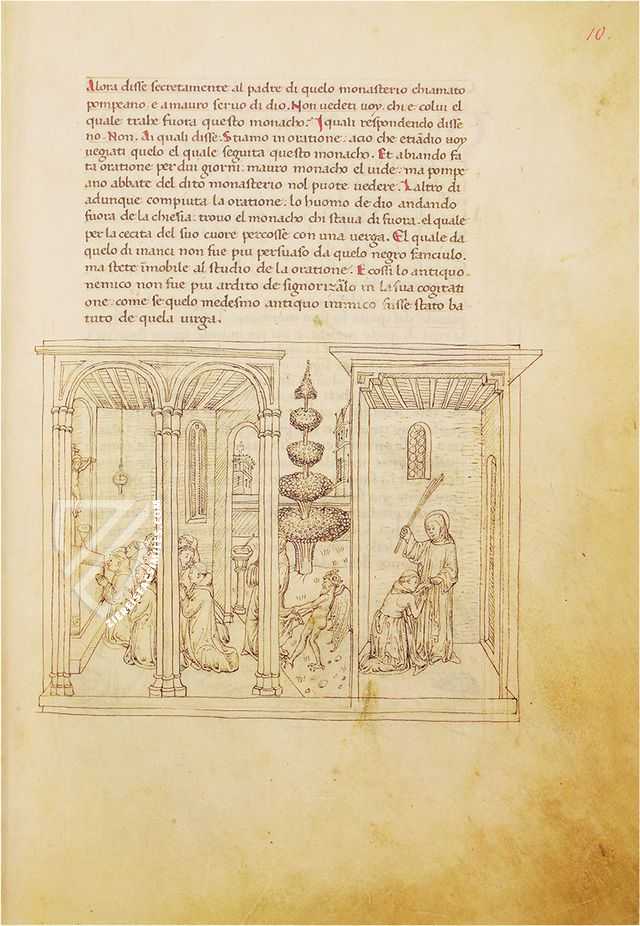
#1 Vita di San Benedetto
Language: Italian
(1,000€ - 3,000€)
- Treatises / Secular Books
- Apocalypses / Beatus
- Astronomy / Astrology
- Bestiaries
- Bibles / Gospels
- Chronicles / History / Law
- Geography / Maps
- Saints' Lives
- Islam / Oriental
- Judaism / Hebrew
- Single Leaf Collections
- Leonardo da Vinci
- Literature / Poetry
- Liturgical Manuscripts
- Medicine / Botany / Alchemy
- Music
- Mythology / Prophecies
- Psalters
- Other Religious Books
- Games / Hunting
- Private Devotion Books
- Other Genres
- Afghanistan
- Armenia
- Austria
- Belgium
- Colombia
- Croatia
- Cyprus
- Czech Republic
- Denmark
- Egypt
- Ethiopia
- France
- Germany
- Greece
- Hungary
- India
- Iran
- Iraq
- Israel
- Italy
- Japan
- Lebanon
- Luxembourg
- Mexico
- Morocco
- Netherlands
- Palestine
- Peru
- Poland
- Portugal
- Russia
- Serbia
- Spain
- Sri Lanka
- Sweden
- Switzerland
- Syria
- Turkey
- Ukraine
- United Kingdom
- United States
- Uzbekistan
- Aboca Museum
- Ajuntament de Valencia
- Akademie Verlag
- Akademische Druck- u. Verlagsanstalt (ADEVA)
- Aldo Ausilio Editore - Bottega d’Erasmo
- Alecto Historical Editions
- Alkuin Verlag
- Almqvist & Wiksell
- Amilcare Pizzi
- Andreas & Andreas Verlagsbuchhandlung
- Archa 90
- Archiv Verlag
- Archivi Edizioni
- Arnold Verlag
- ARS
- Ars Magna
- ArtCodex
- AyN Ediciones
- Azimuth Editions
- Badenia Verlag
- Bärenreiter-Verlag
- Belser Verlag
- Belser Verlag / WK Wertkontor
- Benziger Verlag
- Bernardinum Wydawnictwo
- BiblioGemma
- Biblioteca Apostolica Vaticana (Vaticanstadt, Vaticanstadt)
- Bibliotheca Palatina Faksimile Verlag
- Bibliotheca Rara
- Boydell & Brewer
- Bramante Edizioni
- Bredius Genootschap
- Brepols Publishers
- British Library
- C. Weckesser
- Caixa Catalunya
- Canesi
- CAPSA, Ars Scriptoria
- Caratzas Brothers, Publishers
- Carus Verlag
- Casamassima Libri
- Chavane Verlag
- Christian Brandstätter Verlag
- Circulo Cientifico
- Club Bibliófilo Versol
- Club du Livre
- CM Editores
- Collegium Graphicum
- Collezione Apocrifa Da Vinci
- Comissão Nacional para as Comemorações dos Descobrimentos Portugueses
- Coron Verlag
- Corvina
- CTHS
- D. S. Brewer
- Damon
- De Agostini/UTET
- De Nederlandsche Boekhandel
- De Schutter
- Deuschle & Stemmle
- Deutscher Verlag für Kunstwissenschaft
- DIAMM
- Droz
- E. Schreiber Graphische Kunstanstalten
- Ediciones Boreal
- Ediciones Grial
- Ediclube
- Edições Inapa
- Edilan
- Editalia
- Edition Deuschle
- Edition Georg Popp
- Edition Leipzig
- Edition Libri Illustri
- Editiones Reales Sitios S. L.
- Éditions de l'Oiseau Lyre
- Editions Medicina Rara
- Editorial Casariego
- Editorial Mintzoa
- Editrice Antenore
- Editrice Velar
- Edizioni Edison
- Egeria, S.L.
- Eikon Editores
- Electa
- Emery Walker Limited
- Enciclopèdia Catalana
- Eos-Verlag
- Ephesus Publishing
- Ernst Battenberg
- Eugrammia Press
- Extraordinary Editions
- Fackelverlag
- Facsimila Art & Edition
- Facsimile Editions Ltd.
- Facsimilia Art & Edition Ebert KG
- Faksimile Verlag
- Feuermann Verlag
- Folger Shakespeare Library
- Franco Cosimo Panini Editore
- Friedrich Wittig Verlag
- Fundación Hullera Vasco-Leonesa
- G. Braziller
- Gabriele Mazzotta Editore
- Gebr. Mann Verlag
- Gesellschaft für graphische Industrie
- Getty Research Institute
- Giovanni Domenico de Rossi
- Giunti Editore
- Graffiti
- Grafica European Center of Fine Arts
- Guido Pressler
- Guillermo Blazquez
- Gustav Kiepenheuer
- H. N. Abrams
- Harrassowitz
- Helikon
- Hendrickson Publishers
- Henning Oppermann
- Herder Verlag
- Hes & De Graaf Publishers
- Hoepli
- Holbein-Verlag
- Hortus Deliciarum
- Houghton Library
- Hugo Schmidt Verlag
- Idion Verlag
- Il Bulino, edizioni d'arte
- ILte
- Imago
- Insel Verlag
- Instituto Nacional de Antropología e Historia
- Istituto dell'Enciclopedia Italiana - Treccani
- Istituto Ellenico di Studi Bizantini e Postbizantini
- Istituto Geografico De Agostini
- Istituto Poligrafico e Zecca dello Stato
- Italarte Art Establishments
- J. Thorbecke
- Jan Thorbecke Verlag
- Johnson Reprint Corporation
- Josef Stocker
- Josef Stocker-Schmid
- Jugoslavija
- Karl W. Hiersemann
- Kasper Straube
- Kaydeda Ediciones
- Kindler Verlag / Coron Verlag
- Kodansha International Ltd.
- Konrad Kölbl Verlag
- Kurt Wolff Verlag
- La Liberia dello Stato
- La Linea Editrice
- La Meta Editore
- Lambert Schneider
- Landeskreditbank Baden-Württemberg
- Leo S. Olschki
- Les Incunables
- Library of Congress
- Libreria Musicale Italiana
- Lichtdruck
- Lito Immagine Editore
- Lumen Artis
- Lund Humphries
- M. Moleiro Editor
- Maison des Sciences de l'homme et de la société de Poitiers
- Manuscriptum
- Martinus Nijhoff
- Maruzen-Yushodo Co. Ltd.
- MASA
- McGraw-Hill
- Militos
- Millennium Liber
- Müller & Schindler
- Nahar and Steimatzky
- National Library of Wales
- Neri Pozza
- Nova Charta
- Oceanum Verlag
- Odeon
- Orbis Mediaevalis
- Orbis Pictus
- Österreichische Staatsdruckerei
- Oxford University Press
- Pageant Books
- Parzellers Buchverlag
- Patrimonio Ediciones
- Pattloch Verlag
- PIAF
- Pieper Verlag
- Plon-Nourrit et cie
- Prestel Verlag
- Princeton University Press
- Prisma Verlag
- Priuli & Verlucca, editori
- Pro Sport Verlag
- Propyläen Verlag
- Pytheas Books
- Quaternio Verlag Luzern
- Reales Sitios
- Recht-Verlag
- Reichert Verlag
- Reichsdruckerei
- Riehn & Reusch
- Roberto Vattori Editore
- Rosenkilde and Bagger
- Roxburghe Club
- Salerno Editrice
- Sarajevo Svjetlost
- Schöck ArtPrint Kft.
- Scolar Press
- Scrinium
- Scripta Maneant
- Scriptorium
- Siloé, arte y bibliofilia
- SISMEL - Edizioni del Galluzzo
- Sociedad Mexicana de Antropología
- Société des Bibliophiles & Iconophiles de Belgique
- Soncin Publishing
- Sorli Ediciones
- Stainer and Bell
- Studer
- Styria Verlag
- Sumptibus Pragopress
- Szegedi Tudomànyegyetem
- Taberna Libraria
- Tarshish Books
- Taschen
- Tempus Libri
- Testimonio Compañía Editorial
- Thames and Hudson
- The Clear Vue Publishing Partnership Limited
- The Facsimile Codex
- The Folio Society
- The Marquess of Normanby
- The Richard III and Yorkist History Trust
- Tip.Le.Co
- TouchArt
- TREC Publishing House
- TRI Publishing Co.
- Trident Editore
- Typis Regiae Officinae Polygraphicae
- Union Verlag Berlin
- Universidad de Granada
- University of California Press
- University of Chicago Press
- Urs Graf
- Vallecchi
- Van Wijnen
- VCH, Acta Humaniora
- VDI Verlag
- VEB Deutscher Verlag für Musik
- Verlag Anton Pustet / Andreas Verlag
- Verlag Bibliophile Drucke Josef Stocker
- Verlag der Münchner Drucke
- Verlag für Regionalgeschichte
- Verlag Styria
- Vicent Garcia Editores
- W. Turnowsky
- Waanders Printers
- Wiener Mechitharisten-Congregation (Wien, Österreich)
- Wissenschaftliche Buchgesellschaft
- Wydawnictwo Dolnoslaskie
- Xuntanza Editorial
- Zakład Narodowy
- Zollikofer AG




